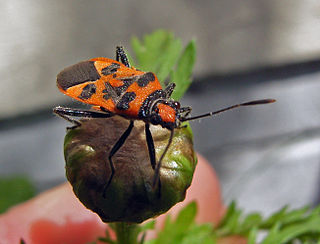
Pentatomidae is a family of insects belonging to the order Hemiptera, generally called shield bugs or stink bugs. Pentatomidae is the largest family in the superfamily Pentatomoidea, and contains around 900 genera and over 4700 species. As hemipterans, the pentatomids have piercing sucking mouthparts, and most are phytophagous, including several species which are severe pests on agricultural crops. However, some species, particularly in the subfamily Asopinae, are predatory and may be considered beneficial.

Coreidae is a large family of predominantly sap-suckling insects in the Hemipteran suborder Heteroptera. The name "Coreidae" derives from the genus Coreus, which derives from the Ancient Greek κόρις (kóris) meaning bedbug.

Pentatominae is a subfamily of Pentatomidae, a family of shield bugs. This subfamily is the largest one within the pentatomidae, having 4937 species. classified in 938 genera. Species on this subfamily are phytophages and several of them have been considered agricultural pests. Some invasive pentatomines such as Halyomorpha halys and Bagrada hilaris have been considered household pests, even inflicting adventitious bites. Higher systematics of the group has been revised by Rider et al.

Coreoidea is a superfamily of true bugs in the infraorder Pentatomomorpha which includes leaf-footed bugs and allies. There are more than 3,300 described species in Coreoidea.

The Lygaeoidea are a sizeable superfamily of true bugs, containing seed bugs and allies, in the order Hemiptera. There are about 16 families and more than 4,600 described species in Lygaeoidea, found worldwide. Most feed on seeds or sap, but a few are predators.

Ricaniidae is a family of planthopper insects, containing over 40 genera and 400 species worldwide. The highest diversity is in tropical Africa and Asia and in Australia, with a few species occurring in the Palearctic. It is one of the smaller families in the planthopper superfamily Fulgoroidea.

Coreinae is a subfamily in the hemipteran family Coreidae.

The Harpactorinae are a large subfamily of the Reduviidae. About 300 genera and 2,000 species worldwide have been described. Some of the species of the genera Zelus, Pselliopus, Sinea, and Apiomerus are of interest as biological pest control agents.

Harpactorini is a tribe of the Harpactorinae. This group is the most diverse of the entire assassin bug family, with 51 genera recognized in the Neotropical Region and 289 genera and 2003 species overall.

The Reduviinae are a subfamily of the reduviid assassin bugs. Many members of the subfamily are nocturnal and their lifecycles are generally poorly known. This subfamily is suspected not to be monophyletic.
The Thyreocoridae are a family of shield bugs, known by common names that include negro bugs or ebony bugs. Historically, a few authors have called this family "Corimelaenidae" (e.g.), but the name Thyreocoridae, published in 1843, has nomenclatural priority over Corimelaenidae, published in 1872. Other classifications have placed them as a subfamily within the broad family Cydnidae.

Pentatomini is a tribe of shield bugs in the subfamily of Pentatominae.

Alydinae is a subfamily of broad-headed bugs in the family Alydidae. There are about 24 genera and more than 140 described species in Alydinae.

Nezarini is a tribe of stink bugs in the family Pentatomidae.

Carpocorini is a tribe of stink bugs in the family Pentatomidae. There are about 15 genera and at least 50 described species in Carpocorini.
Meropachyinae is a subfamily of leaf-footed bugs in the family Coreidae. There are at least 25 genera and 50 described species in Meropachyinae.
Colobathristidae is a family of true bugs in the order Hemiptera. There are more than 20 genera and 90 described species in Colobathristidae.

The Micrelytrinae are a subfamily of bugs in the family Alydidae, based on the type genus Micrelytra Laporte, 1833. Genera are recorded from the Americas, Europe and Asia.

Dulichius is a genus of bugs in the family Alydidae and tribe Micrelytrini. It is notable for species which are ant mimics.

















